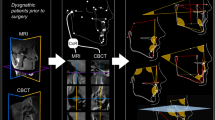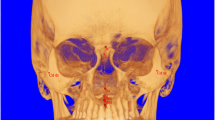Abstract
Objectives
One of the key aspects of three-dimensional (3D) craniofacial cephalometry is the measurement of posterior cranial base angle as this area is deeply involved in craniofacial development. The purpose of our retrospective study was to define the best reproducible 3D posterior cranial base angles among five 3D angles transposed from 2D cephalometry (Cousin, BL1 of Ross and Ravosa, Bjork, Delaire, CBA4 of Liberman) and seven 3D angles based on physical anthropology studies and on new concepts (R1 to R7). The null hypothesis was that all 3D posterior cranial base angles were equally reproducible.
Material and methods
We used a preoperative low-dose computed tomography (CT) data from 20 adult patients undergoing orthognathic surgery after approval by local ethical committee. Two independent observers performed two series of 23 3D landmark identifications on 3D CT surface rendering of each patient using Maxilim software. Then, the same observers performed twice 3D cephalometric analyses (23 landmarks, 4 midpoints, 19 planes) that provided the automatic measurement of 12 posterior cranial base angles.
Results
Inter-observer correlation coefficient varied from 0.545 (Cousin) to 0.695 (CBA4 of Liberman) and from −0.177 (R2) to 0.827 (R4).
Conclusions
The null hypothesis was rejected. The most reproducible angle was 3D angle R4 based on “basion,” “superior optic” (right, left), and “crista galli inferior” landmarks.
Clinical relevance
R4 angle might be used as reference 3D posterior cranial base angle in further clinical studies involving 3D cephalometry as a diagnostic tool for orthodontics and for orthognathic surgery.



Similar content being viewed by others
References
Lieberman D, McCarthy RC (1999) The ontogeny of cranial base angulation in humans and chimpanzee and its implications for reconstructing pharyngeal dimensions. J Human Evol 36:487–517
Alves PV, Mazuchelli J, Patel PK, Bolognese AM (2008) Cranial base angulation in Brazilian patients seeking orthodontic treatment. J Craniofac Surg 19:334–338
Nie X (2005) Cranial base in craniofacial development: developmental features, influence on facial growth, anomaly, and molecular basis. Acta Odontol Scand 63:127–135
Olszewski R, Frison L, Wisniewski M, Denis JM, Vynckier S, Cosnard G, Zech F, Reychler H (2013) Reproducibility of three-dimensional cephalometric landmarks in cone-beam and low-dose computed tomography. Clin Oral Investig 17:285–292
Olszewski R, Tanesy O, Cosnard G, Zech F, Reychler H (2010) Reproducibility of osseous landmarks used for computed tomography based three-dimensional cephalometric analyses. J Craniomaxillofac Surg 38:214–221
Olszewski R, Reychler H, Cosnard G, Denis JM, Vynckier S, Zech F (2008) Accuracy of three-dimensional (3D) craniofacial cephalometric landmarks on a low-dose 3D computed tomograph. Dentomaxillofac Radiol 37:261–267
Olszewski R, Zech F, Cosnard G, Nicolas V, Macq B, Reychler H (2007) Three-dimensional computed tomography cephalometric craniofacial analysis: experimental validation in vitro. Int J Oral Maxillofac Surg 36:828–833
Swennen GR, Schutyser F, Barth EL, De Groeve P, De Mey A (2006) A new method of 3-D cephalometry part I: the anatomic Cartesian 3-D reference system. J Craniofac Surg 17:314–325
Gateno J, Xia JJ, Teichgraeber JF (2011) New 3-dimensional cephalometric analysis for orthognathic surgery. J Oral Maxillofac Surg 69:606–622
Yitschaky O, Redlich M, Abed Y, Faerman M, Casap N, Hiller N (2011) Comparison of common hard tissue cephalometric measurements between computed tomography 3D reconstruction and conventional 2D cephalometric images. Angle Orthod 81:11–16
van Vlijmen OJ, Maal T, Bergé SJ, Bronkhorst EM, Katsaros C, Kuijpers-Jagtman AM (2010) A comparison between 2D and 3D cephalometry on CBCT scans of human skulls. Int J Oral Maxillofac Surg 39:156–160
Herlin C, Largey A, deMatteï C, Daurès JP, Bigorre M, Captier G (2011) Modeling of the human fetal skull base growth: interest in new volumetrics morphometric tools. Early Hum Dev 87:239–245
Lorensen WE, Cline HE (1987) Marching cubes: a high resolution 3D surface construction algorithm. Comp Graph 21:163–169
McCullagh P (1983) Quasi-likelihood functions. Ann Stat 11:59–67
Chaganty NR, Shults J (1999) On eliminating the asymptotic bias in the quasi-least squares estimate of the correlation parameter. J Stat Plan Inf 76:145–161
Shrout PE, Fleiss JL (1979) Intraclass correlations: uses in assessing rater reliability. Psychol Bull 86:420–428
Connnor SEJ, Arscott T, Berry J, Greene L, O’Gorman R (2007) Precision and accuracy of low-dose CT protocols in the evaluation of skull landmarks. Dentomaxillofac Radiol 36:270–276
Pancherz H, Hansen K (1984) The nasion-sella reference line in cephalometry: a methodologic study. Am J Orthod 86:427–434
Andredaki M, Koumantanou A, Dorotheou D, Halazonetis DJ (2007) A cephalometric morphometric study of the sella turcica. Eur J Orthod 29:449–456
Pittayapat P, Jacobs R, Odri GA, Vasconcelos Kde F, Willems G, Olszewski R (2015) Reproducibility of the sella turcica landmark in three dimensions using a sella turcica-specific reference system. Imaging Sci Dent 45:15–22
Muramatsu A, Nawa H, Kimura M, Yoshida K, Maeda M, Katsumata A, Ariji E, Goto S (2008) Reproducibility of maxillofacial anatomic landmarks on 3-dimensional computed tomographic images determined with the 95% confidence ellipse method. Angle Orthod 78:396–402
Bjork A (1951) The significance of growth changes in facial pattern and their relationship to changes in occlusion. Dent Rec 71:197–208
Bjork A (1955) Cranial base development. Am J Orthod 41:198–225
Stamrud L (1959) External and internal cranial base. Acta Odontol Scand 17:239–266
Melsen B (1969) Time of closure of shepeno-occipital synchondrosis determined on dry skulls. A radiographic craniometric study. Acta Odontol Scand 27:73–90
George SL (1978) A longitudinal and cross-sectional analysis of the growth of postnatal cranial base angle. Am J Phys Anthropol 49:171–178
Cousin RP, Fenart R, Deblock R (1981) Variations ontogéniques des angles basicraniens et faciaux. Bull Mem soc Anthropol Paris 8:189–212
Delaire J, Schendel SA, Tulasne JF (1981) An architectural and structural craniofacial analysis: a new lateral cephalometric analysis. Oral Surg Oral Med Oral Pathol 52:226–238
Cameron J (1924) The craniofacial axis of Huxley. Part I. Embryological considerations. Trans Roy Soc Can 18:115–123
Ford EHR (1958) Growth of the human cranial base. Am J Orthod 44:498–506
Moss ML (1958) The pathogenesis of artificial cranial deformation. Am J Phys Anthropol 16:269–286
Ross C, Ravosa MJ (1993) Basicranial flexion, relative brain size, and facial kyphosis in non-human primates. Am J Phys Anthropol 91:305–324
Ross C, Henneberg M (1995) Basicranial flexion, relative brain size, and facial kyphosis in Homo sapiens and some fossil hominids. Am J Phys Anthropol 98:575–593
Enlow DH, Moyers RE (1971) Growth and architecture of the face. J Am Dent Assoc 82:763–774
Flugel C, Schram K, Rohen J (1993) Post-natal development of the skull base, neuro- and viscerocranium in man and monkey: morphometric evaluation of CT scans and radiograms. Acta Anat 146:71–80
Scott JH (1958) The cranial base. Am J Phys Anthropol 16:319–348
Author information
Authors and Affiliations
Corresponding author
Ethics declarations
Conflict of interest
The authors declare that they have no conflict of interest.
Funding
There was no funding for this study.
Ethical approval
All procedures performed in studies involving human participants were in accordance with the ethical standards of the institutional and/or national research committee and with the 1964 Helsinki declaration and its later amendments or comparable ethical standards.
Informed consent
Informed consent was obtained from all individual participants included in the study.
Rights and permissions
About this article
Cite this article
Olszewski, R., Frison, L., Schoenarts, N. et al. Reproducibility of three-dimensional posterior cranial base angles using low-dose computed tomography. Clin Oral Invest 21, 2407–2414 (2017). https://doi.org/10.1007/s00784-016-2036-4
Received:
Accepted:
Published:
Issue Date:
DOI: https://doi.org/10.1007/s00784-016-2036-4




